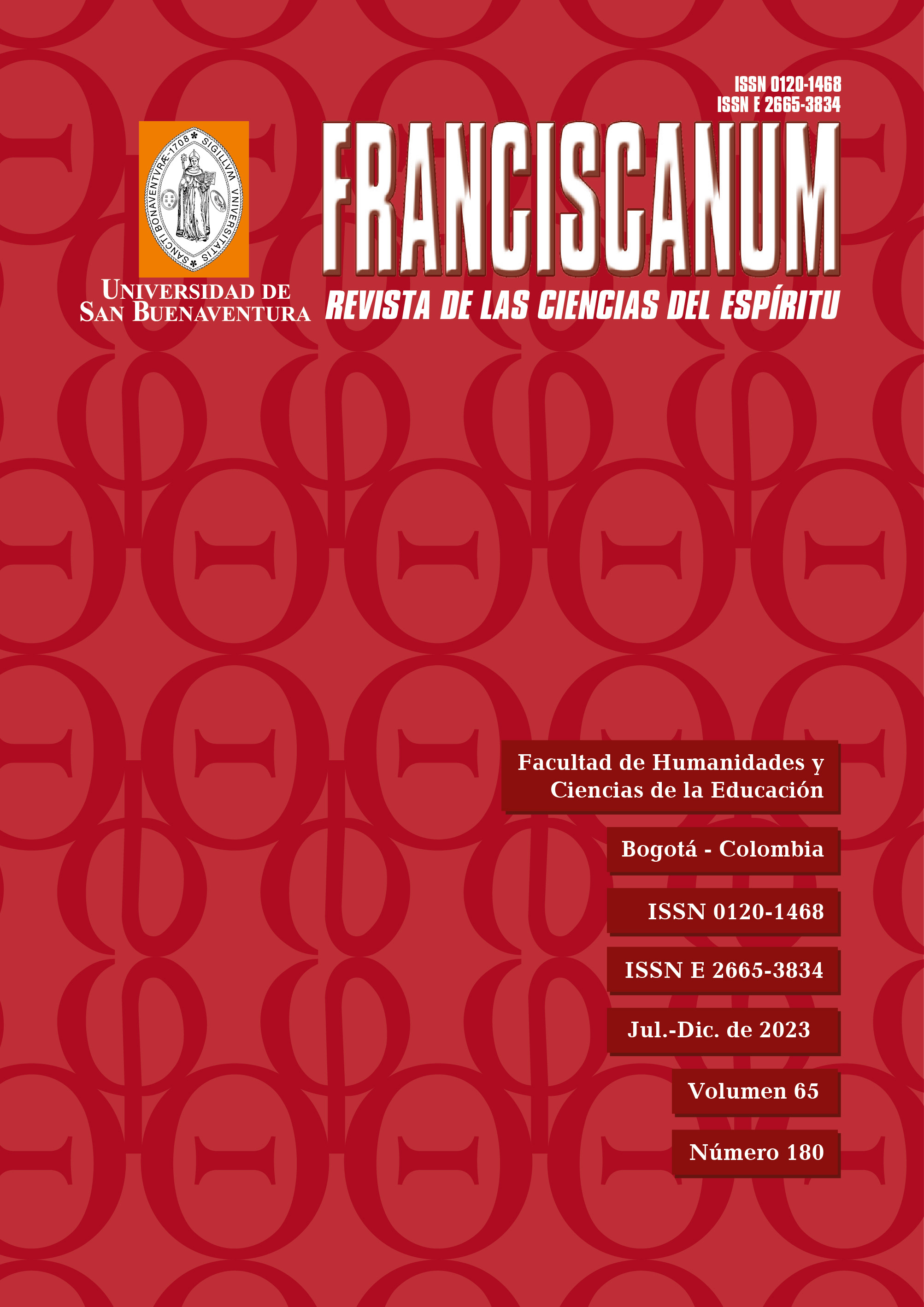This journal provides immediate open access to its content, based on the principle that giving the public free access to research helps a greater global exchange of knowledge.
Therefore, the Creative Commons 4.0 Attribution Attribution - Equal Share (by-sa) License is accepted: The commercial use of the work and the possible derived works is permitted, the distribution of which must be done with a license equal to that regulates the original work.
http://creativecommons.org/licenses/by-sa/4.0/
Along these same lines and in line with the Open Access policy, it is clarified that the authors maintain their rights to articles, without restrictions and, in the same way, they maintain their publication rights, without restrictions. They are only asked to reference the number of the Franciscanum magazine where the article initially appeared.
Abstract
Para Pablo, el acontecimiento pascual de Cristo supuso un momento esencial para la Historia. En la carta a los Gálatas, podemos percibir el enorme esfuerzo de construcción de un relato religioso sobre la base del diálogo de dos cosmovisiones: la judía y la helenisticorromana. En continuidad con el teocentrismo bíblico, Dios Creador es el protagonista absoluto de la historia y el cosmos. Desde la novedad cristológica y pragmática de su apostolado, la historia se convierte en un escenario orientado hacia la participación de Cristo, bajo el impulso del Espíritu Santo, que se visibiliza en las pequeñas Iglesias cristianas
References
Barclay, William. Comentario al Nuevo Testamento, vol. 8, Romanos, Terrassa: CLIE 2012.
Boer, Martinus C. D., Galatians. A Commentary (New Testament Library). Louisville: Westminster John Knox Press, 2011.
Carter, Warren. The Roman Empire and the New Testament: An Es¬sential Guide. Nashville: Abingdon Press, 2010.
Church, Philip. Hebrews and the Temple: Attitudes to the Temple in Second Temple Judaism and in Hebrews. Leiden, Boston: Brill, 2017.
Corriente, Fernando y Piñero, Antonio. «Libro de los Jubileos. Traducción de la versión etiópica». En Apócrifos del Antiguo Testamento. Díez Macho, Alejandro (dir.), vol. II, Madrid: Ediciones Cristiandad 1987: 87-193.
Cortés Minguella, Enric. Los discursos de adiós de Gn 49 a Jn 13-17: pistas para la historia de un género literario en la antigua literatura judía. Barcelona: Herder 1976.
Fisch, Yael. «“Midrash-Pesher”: A Shared Technique of Inter¬pretation in Qumran, Paul, and the Tannaim». Revue de Qumran 32, n.° 2 (2020): 213-233.
Foster, Robert B. Renaming Abraham’s Children: Election, Eth¬nicity, and the Interpretation of Scripture in Romans 9 (WUNT 241). Tubinga: Mohr Siebeck 2016.
García Martínez, Florentino y Trebolle Barrera, Julio. Los hombres de Qumran, literatura, estructura social y concepciones religiosas. Madrid: Editorial Trotta 1993.
Glicksam, A. T. Wisdom of Solomon 10: A Jewish Hellenistic Reinterpretation of Early Israelite History through Sapiential Lenses (Deuterocanonical and Cognate Literature Studies 9). Berlín, Boston: Walter de Gru¬yter, 2011.
Gnilka, Joachim. Jesús de Nazaret. Mensaje e historia. Barcelona: Herder, 1993.
Gnilka, Joachim. Pablo de Tarso. Apóstol y testigo. Barcelona: Herder, 2009.
Hays, Richard B. Echoes of Scripture in the Letters of Paul. New Haven: Yale University Press, 1989.
Lappenga, Benjamin J. «Misdirected Emulation and Paradoxical Zeal: Paul’s Redefinition of “The Good” as Object of Zêlos in Galatians 4,12-20». JBL 131 (2012): 775-796.
Lewis, Robert Brian. Paul’s ‘Spirit of Adoption’ in its Roman Imperial Context. Londres: Bloomsbury Publishing, 2016.
Martin, Troy W. «Circumcision in Galatia and the Holiness of God’s Ecclesiae». En Holiness and Ecclesiology in the New Testament, Brower, Kent y Johnson, Andy (eds.). Michigan, Cambridge: Wm. B. Eerdmans Publishing, 2007, 219-237.
Mermelstein, Ari. Creation, Covenant, and the Beginnings of Ju¬daism. Reconceiving Historical Time in the Second Temple Period (JSJ.S). Leiden: Brill, 2014.
Mermelstein, Ari. «When History Repeats Itself: The Theological Significance of the Abrahamic Covenant in Early Jewish Writings». JSP 27, n.° 2 (2017): 113-142.
Momigliano, Arnaldo. Essays in Ancient and Modern Historiogra¬ph. Chicago: Chicago University Press, 1977.
Penna, Romano. Lettera ai Romani (Scritti delle origini cristiane 6). Bolonia: EDB, 2010.
Peppard, Michael. The Son of God in the Roman World. Divine Sonship in Its Social and Political Context. Oxford: Oxford University Press, 2011.
Pitta, Antonio. Lettera ai Galati. Bolonia: EDB, 1996.
Portier-Young, Anathea E. Apocalypse against Empire: Theologies of Resistance in Early Judaism. Grand Rapids: Wm. B. Eerdmans Publishing, 2014.
Schiffman, Lawrence H. The Eschatological Community of the Dead Sea Scrolls (SBLMS 38). Atlanta: Scholars, 1989.
Schiffman, Lawrence H. Qumran and Jerusalem: Studies in the Dead Sea Scrolls and the History of Judaism (Studies in the Dead Sea scrolls and Related Literature). Grand Rapids, Cam¬bridge: Wm. B. Eerdmans Publishing, 2010.
Scott, James M. «Cosmopolitanism in Gal 3:28 and the Divine Per¬formative Speech-Act of Paul’s Gospel». ZNW 112 (2021): 180-200.
Williams, David John. Paul’s Metaphors. Their Context and Character, Ada (Michigan): Baker Publishing Group, 2003.
Williams, Logan A., «Disjunction in Paul: Apocalyptic or Christo¬morphic? Comparing the Apocalypse of Weeks with Gala¬tians». NTS 64 (2018): 64-80.
Yoon, David I. «Discourse Analysis and the Textual Metafunction: Analyzing the Texture of Galatians 4,12-20». Filología neo¬testamentaria 47 (2014): 83-110.



















